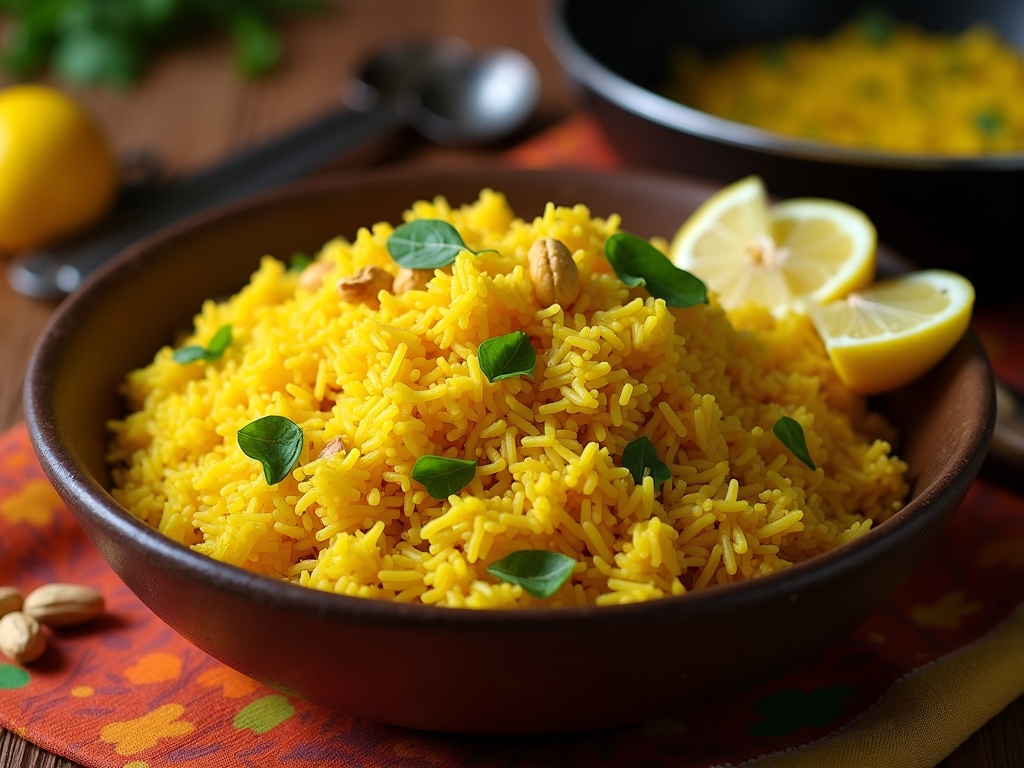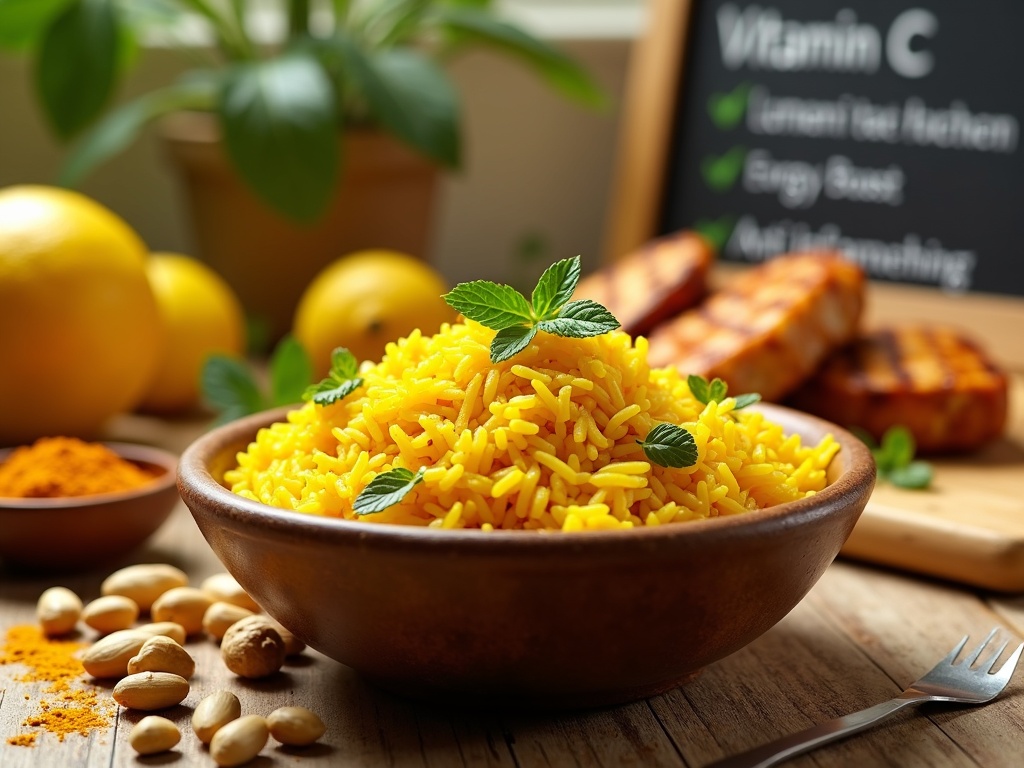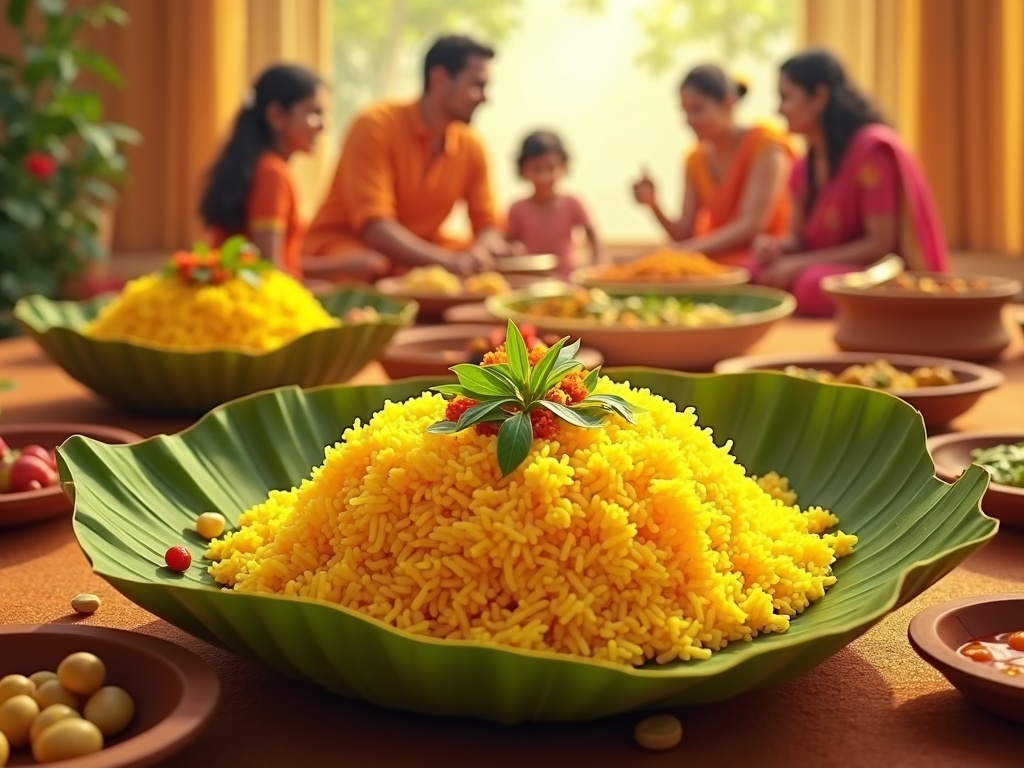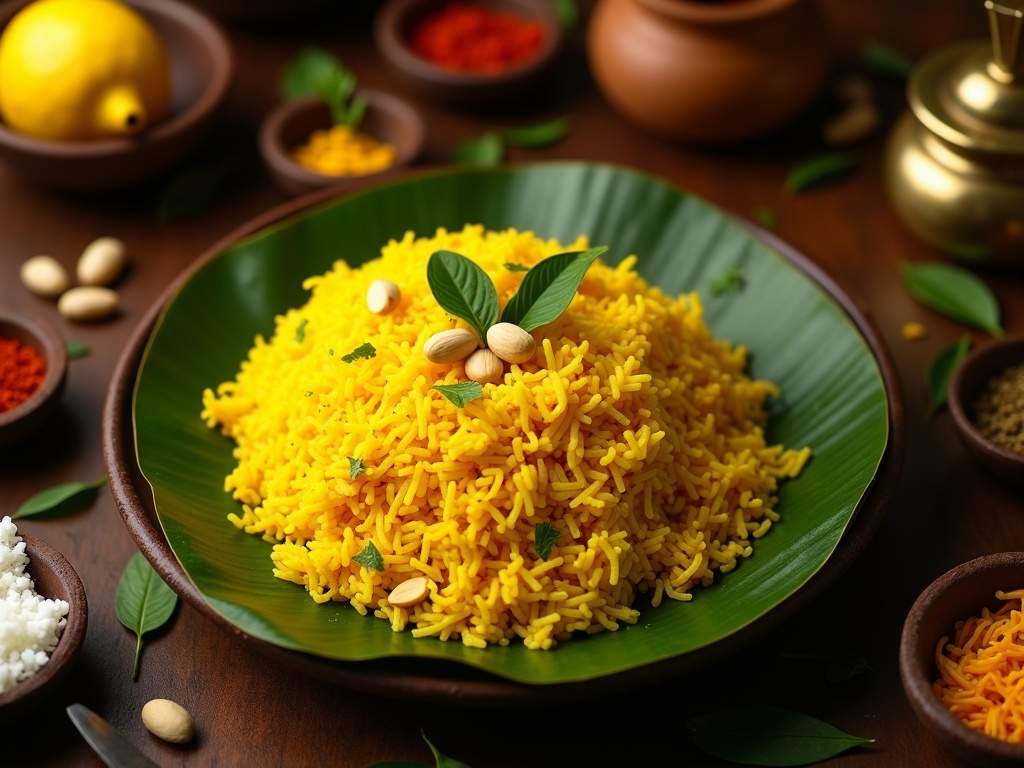Lemon rice, a vibrant South Indian culinary classic, combines tangy lemon juice with aromatic spices to transform simple rice into an extraordinary dish that’s both practical and flavorful. This beloved staple holds significant cultural importance across South India, appearing in everything from daily lunch boxes to religious ceremonies and festivals, showcasing how basic ingredients can create a meal that’s deeply satisfying.
Find In This Article
Key Takeaways
- Lemon rice serves as an ideal lunch box companion because the lemon acts as a natural preservative, keeping the rice fresh for hours while maintaining its flavor at room temperature.
- The dish achieves its distinctive character through a tempering (tadka) of mustard seeds, curry leaves, dried red chilies, and urad dal, with turmeric providing the signature golden color.
- Regional variations exist across South India, with Karnataka adding coconut, Tamil Nadu pairing it with potato curry, and Andhra Pradesh incorporating additional red chilies for extra heat.
- A serving of lemon rice provides moderate nutrition with 220-250 calories, 4-6g of protein, and beneficial anti-inflammatory properties from the combination of turmeric and lemon.
- Beyond its culinary appeal, lemon rice holds cultural significance at celebrations like Pongal and weddings, representing prosperity while demonstrating South Indian ingenuity in transforming leftover rice.
A South Indian Culinary Classic
Lemon rice stands as one of the most beloved dishes in South Indian cuisine, bringing together the simple yet powerful combination of rice, tangy lemon juice, and aromatic spices. This bright yellow dish isn’t just delicious—it’s a significant player in India’s massive rice market, which was valued at $81.45 billion in 2020 and is expected to grow to an impressive $113.56 billion by 2026.
I’ve found that lemon rice represents the heart of Indian cooking philosophy: transforming basic ingredients into something extraordinary. The dish showcases how staple ingredients found in virtually every Indian kitchen can create a meal that’s both satisfying and bursting with flavor.
Cultural Significance and Traditions
Lemon rice holds a special place in South Indian traditions and daily life. The dish frequently appears during important festivals and celebrations, where its vibrant yellow color symbolizes prosperity and happiness. Many families prepare it as an offering during religious ceremonies, appreciating its balance of simplicity and flavor.
Beyond special occasions, lemon rice has earned its reputation as the perfect lunch box companion. Its practical benefits make it ideal for packed meals:
- The lemon acts as a natural preservative, keeping the rice fresh for hours
- It tastes delicious at room temperature
- The dish doesn’t dry out like plain rice might
- Its distinct flavor remains enjoyable even after sitting for some time
This practicality explains why countless children and working adults across South India find lemon rice in their lunch boxes daily. The dish provides a filling meal that maintains its integrity throughout the day.
The Perfect Balance of Flavors
What makes lemon rice truly special is its masterful balance of flavors and textures. The tanginess from fresh lemon juice cuts through the richness of the tempering spices, creating a harmonious taste experience. I’ve discovered that the key components that give lemon rice its distinctive character include:
The tempering (or tadka) of mustard seeds, curry leaves, dried red chilies, and urad dal creates the aromatic foundation. Turmeric provides both the signature golden color and earthy undertone. Meanwhile, the bright acidity from lemon juice transforms ordinary rice into something extraordinary.
For those looking to explore other flavorful rice variations, pilau rice offers a fragrant alternative with its blend of whole spices. If you prefer a simpler option, jeera rice delivers the wonderful aroma of cumin seeds. And for those who enjoy fusion cuisine, Chinese fried rice provides an entirely different flavor profile while still utilizing rice as its base.
What I appreciate most about lemon rice is its adaptability. The dish can be enjoyed as a main course paired with yogurt and papadum, or as a side dish accompanying more complex curries. Its versatility makes it appropriate for both everyday meals and special occasions.
The growing market value of rice products in India reflects how deeply embedded dishes like lemon rice are in the cultural fabric. As a staple that appears on tables across South India daily, it represents both culinary tradition and practical home cooking at its finest.
The beauty of lemon rice lies in its accessibility—anyone with basic cooking skills can prepare it, yet the results deliver complex flavors that satisfy even the most discerning palates. This balance of simplicity and satisfaction explains why it has remained a beloved classic throughout generations.
Essential Ingredients and Preparation
The perfect lemon rice starts with selecting quality ingredients that create that distinctive tangy flavor and beautiful yellow color. I’ve found that preparing this dish is quite straightforward once you have everything measured and ready.
Core Ingredients and Cooking Method
To make authentic lemon rice, I start with 1 cup of well-cooked basmati or long-grain rice. The rice should be fluffy and each grain separate – similar to how jeera rice should turn out. For the signature tanginess, 1-2 tablespoons of fresh lemon juice per serving gives the best results.
The flavor base consists of:
- 1 teaspoon mustard seeds
- ½ teaspoon turmeric powder (for that golden color)
- 2 finely chopped green chilies
- ¼ cup peanuts for crunch
- 10-12 curry leaves for aroma
- Salt to taste
I begin by preparing the tempering (tadka). In a pan with hot oil, I add mustard seeds and wait for them to splutter. Then I add peanuts and toast them until golden brown. Next come the green chilies and curry leaves, which release their aromatic oils when they hit the hot pan. The turmeric powder goes in last, cooking just for 30 seconds to avoid bitterness.
The cooked rice is then gently folded into this spice mixture. I’m careful not to break the rice grains during mixing – a light hand is key here, much like when preparing pilau rice. Once mixed, I drizzle fresh lemon juice over the rice and fold again to distribute the tanginess evenly.
For rice preparation, you have two excellent options. The stovetop method gives you more control over the texture – cook the rice with a 1:2 ratio of rice to water until tender but still firm. Alternatively, a rice cooker offers convenience and consistent results, especially useful when preparing other dishes simultaneously, similar to making Chinese fried rice.
The final dish should have distinct yellow-colored grains, a pleasant citrus aroma, and a balanced flavor profile where the tanginess of lemon complements the nutty crunch of peanuts and the aromatic spices.

Regional Variations and Serving Suggestions
Lemon rice exhibits fascinating regional diversity across South India, with each state adding its unique twist to this tangy delight. I’ve discovered that these variations aren’t just about different ingredients—they reflect the cultural heritage of each region.
Regional Styles
Karnataka-style lemon rice includes freshly grated coconut, adding a delightful texture and subtle sweetness that balances the tanginess. The coconut creates a more complex flavor profile, making it particularly satisfying as a standalone meal.
In Tamil Nadu, lemon rice takes on a different character. It’s commonly paired with simple potato curry or crispy papad, creating a perfect balance of flavors and textures. The combination works brilliantly for lunch boxes or picnics since the rice itself is dry and travels well.
Andhra Pradesh’s version kicks things up a notch with additional red chilies. This preparation brings extra heat that complements the sourness of lemon. It’s particularly popular during festivals and family gatherings where bold flavors are appreciated.
Storage and Meal Prep Tips
I’ve found lemon rice dishes incredibly practical for busy weekdays. Here’s how to make the most of your leftovers:
- Store in the refrigerator for up to 2 days in an airtight container
- For meal prep, portion the rice into individual containers for grab-and-go lunches
- Always add a fresh squeeze of lemon juice when reheating to revitalize the flavor
- Keep tempering ingredients like curry leaves and mustard seeds separate if possible for maximum freshness
For variety in your meal prep rotation, consider alternating between jeera rice and lemon rice for different flavor profiles throughout the week.
When serving lemon rice at gatherings, I like to create a rice bar with different options. Placing lemon rice alongside Chinese fried rice gives guests tasty choices that satisfy different preferences. This approach has always been a hit at my potluck dinners, offering both familiar comfort and exciting flavors on one table.
Health Benefits and Nutrition Facts
I’ve found lemon rice to be an excellent addition to any meal plan, offering a balanced combination of flavor and nutrition. This vibrant dish not only delights the taste buds but also provides several health benefits worth considering.
Nutritional Profile
A standard cup serving of lemon rice typically contains between 220-250 calories, making it a moderate-calorie option that fits well into a balanced diet. The dish provides 4-6g of protein, which helps with muscle maintenance and repair throughout the day.
Carbohydrates in lemon rice range from 35-40g per serving, providing the energy needed for daily activities. These carbs are accompanied by 9-12g of fat, primarily from peanuts and the oil used in preparation, adding both flavor and satiety.
One of the standout nutritional benefits is the vitamin C content. The lemon juice incorporated into the dish contributes approximately 10-15% of your daily vitamin C requirements. This nutrient is essential for:
- Immune system support
- Collagen production for skin health
- Enhanced iron absorption from plant foods
- Protection against cellular damage
The combination of turmeric and lemon in this dish creates a powerful anti-inflammatory effect, potentially helping to reduce inflammation throughout the body. This makes flavored rice dishes like lemon rice a smart choice for those looking to incorporate more anti-inflammatory foods into their diet.
Functional Benefits
Lemon rice serves as an excellent source of quick energy due to its carbohydrate content. I’ve noticed it’s particularly satisfying when I need sustained energy throughout the day, as the combination of carbs with healthy fats from peanuts helps maintain stable blood sugar levels.
The healthy fats present in lemon rice contribute significantly to its satiety factor. These fats help you feel fuller longer, potentially reducing the likelihood of snacking between meals. When compared to plain jeera rice or other simpler preparations, the fat content in lemon rice gives it an edge in terms of satisfaction.
The antioxidant properties of lemon rice shouldn’t be overlooked. The combination of turmeric, lemon, and other spices creates a dish rich in compounds that help combat oxidative stress in the body. These antioxidants work to neutralize harmful free radicals that can damage cells and contribute to aging and disease.
For those watching their diet, lemon rice can be a versatile option that’s easy to adjust. It pairs beautifully with protein sources like grilled chicken or tofu to create a complete meal. The dish also compares favorably to other flavored rice options like Chinese fried rice, often containing less oil while still delivering satisfying flavor.
I’ve found that incorporating lemon rice into my meal rotation provides a nice balance of nutrition and taste. The turmeric content offers potential anti-inflammatory benefits that may support joint health and overall wellness. Meanwhile, the combination of complex carbohydrates and healthy fats provides sustained energy throughout the day.
The nutritional profile of lemon rice makes it a practical choice for everyday meals. With its moderate calorie count, decent protein contribution, and beneficial micronutrients, it’s a dish that satisfies both culinary and nutritional needs without excess.

Cultural Impact and Traditional Uses
Lemon rice holds a special place in South Indian culture, serving as more than just a quick meal option. I’ve seen how this vibrant yellow dish brings families together and graces important celebrations with its tangy aroma and distinctive flavor.
Celebrations and Festivals
Lemon rice plays an essential role during the Pongal festival, a harvest celebration where traditional foods symbolize prosperity and gratitude. This simple yet flavorful dish appears on banana leaves alongside other festive offerings, bringing bright color and zesty taste to the celebration. Wedding ceremonies in South India also feature lemon rice, often served to guests as part of elaborate feasts that showcase regional culinary traditions.
In South Indian households, lemon rice represents everyday culinary ingenuity. Families prepare this dish regularly, appreciating how it transforms leftover rice into something fresh and exciting. The dish demonstrates the remarkable versatility of simple ingredients – rice, lemon, and spices combine to create something far greater than the sum of their parts.
I’ve noticed that lemon rice maintains its prominence in modern Indian cuisine despite changing food trends. Its cultural significance hasn’t diminished as:
- It serves as a portable meal for travelers and workers
- It represents sustainability through repurposing leftover rice
- It connects younger generations to their culinary heritage
- It adapts well to contemporary health-conscious eating patterns
The tradition of lemon rice extends beyond just South India. Similar variations appear in other regional cuisines, like the fragrant jeera rice from North India or the festive pilau rice served at celebrations. Each maintains its distinct character while sharing rice as a common foundation.
Unlike heavier rice preparations such as Chinese fried rice, lemon rice showcases the Indian preference for lighter, spice-forward flavors that let individual ingredients shine. This cultural approach to cooking reflects broader values of balance and harmony in South Indian cuisine.
The cultural impact of lemon rice extends far beyond its taste – it represents community, celebration, and the passing down of culinary traditions through generations of skilled home cooks who maintain this delicious connection to their heritage.

Sources:
Indian Rice Market Analysis – Forecast 2021-2026
Journal of Food Composition – South India Nutrition
South Indian Heritage – Culinary Traditions Guide

